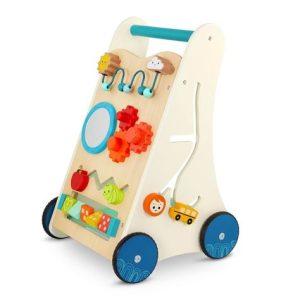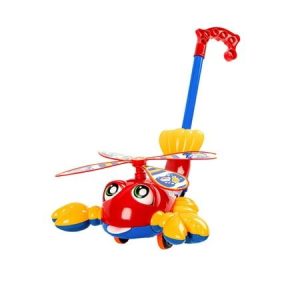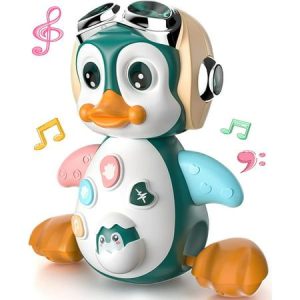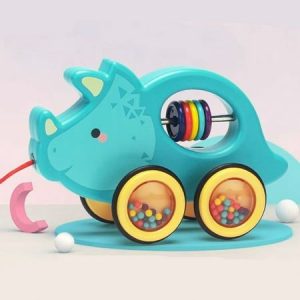Walking toys are a delightful and vibrant category within the vast world of children’s playthings. Designed to both entertain and support little ones as they embark on their walking journey, these toys come in a dazzling array of shapes, sizes, and features. Whether you’re a new parent eagerly anticipating this monumental milestone or a seasoned caregiver looking to refresh your knowledge, this comprehensive guide delves into the world of walking toys.
Understanding the Stages of Walking Development
Before diving into the fantastic world of walking toys, it’s helpful to gain a basic understanding of the fascinating developmental stages that lead a tiny tot to become a confident walker. Each child progresses at their own pace, but here’s a general roadmap:
Rocking and Rolling (6-8 months):
Around this time, most babies develop the strength and coordination to rock back and forth on their hands and knees, a precursor to crawling.
Crawling (8-10 months):
This exciting phase sees babies propel themselves across the floor, strengthening the muscles they’ll need for walking.
Pulling Up (8-10 months):
Using furniture or walls for support, babies begin to pull themselves up to a standing position.
Cruising (10-14 months):
Holding onto furniture or walls, babies cruise sideways, taking tentative steps with one foot in front of the other.

How Walking Toys Can Help
Walking toys come into play during the cruising stage, offering a sense of security and stability as your child practices taking those first steps. Here’s a glimpse into how these toys can aid your little one’s walking development:
- Provide Support: Walking toys offer a sturdy base that your child can hold onto while practicing walking, fostering confidence and a sense of balance.
- Encourage Movement: Many walking toys feature interactive elements or sounds that entice your child to take steps, keeping them motivated.
- Develop Motor Skills: Pushing, pulling, and maneuvering a walking toy strengthens gross motor skills essential for walking.
- Add Fun: Playtime is key to a child’s development, and walking toys make taking those first steps an enjoyable experience.
Choosing the Right Walking Toy
With countless walking toys available, selecting the perfect one for your child can feel overwhelming. Here are some factors to consider:
- Age and Development: Consider your child’s age and developmental stage. Opt for a toy that offers the right level of support and challenge.
- Safety: Ensure the toy is sturdy and has a wide base to prevent tipping. Look for smooth, rounded edges and non-toxic materials.
- Features: Does the toy have lights, sounds, or detachable activity panels to keep your child engaged?
- Durability: Choose a toy made from high-quality materials that can withstand curious exploration and inevitable bumps.

Types of Walking Toys
Walking toys encompass a diverse range of designs, each offering unique benefits:
- Push and Pull Wagons: These classic toys provide a wide, stable base for your child to hold onto as they walk behind. Many wagons come with storage compartments for favorite toys, adding to the fun.
- Activity Walkers: These feature-packed walkers often boast light-up buttons, playful sounds, and spinning toys, keeping your child entertained while they practice walking.
- Scooters: While not technically walkers, ride-on scooters can help strengthen leg muscles and coordination in preparation for walking. Opt for sturdy, three-wheeled scooters for added stability.
- Musical Walkers: These walkers incorporate musical elements that activate with movement, encouraging your child to take steps.
Fun and Safe Play with Walking Toys
Here are some tips to ensure your child has a safe and enjoyable experience with walking toys:
- Clear the path: Remove any obstacles that could cause your child to trip or stumble.
- Provide supervision: Always supervise your child while they’re using a walking toy.
- Encourage exploration: Let your child explore the features of the toy at their own pace.
- Rotate toys: Offer a variety of walking toys to keep playtime fresh and engaging.
Walking toys can be a delightful companion on your child’s walking journey. By understanding the developmental stages, considering your child’s needs, and choosing the right toy, you can transform those first steps into a memorable and rewarding experience.

Beyond the First Steps: Continued Learning with Walking Toys
While toys are fantastic for those initial wobbly steps, their usefulness extends far beyond that initial milestone. Here’s how toys can continue to play a role in your child’s development:
- Fine Motor Skills: Many toys incorporate buttons, levers, and manipulable features that help strengthen tiny fingers and promote hand-eye coordination.
- Cognitive Development: برخی از اسباببازیهای راهرفتن ( niektóre zabawki do chodzenia) [some walking toys] include shape sorters, color matching games, and other interactive elements that stimulate cognitive development.
- Imaginative Play: Toys can spark imaginative play. A simple wagon can transform into a pirate ship or a grocery delivery truck, letting your child’s creativity flourish.

Safety Tips for Continued Play
As your child becomes a more confident walker, here are some safety reminders to keep in mind:
- Watch out for falls: Even the most sure-footed toddlers can take a tumble. Maintain supervision, especially near stairs or uneven surfaces.
- Choose the right walking toy: As your child grows, ensure the walking toy is still age-appropriate and not a tripping hazard.
- Store it safely: When playtime is over, put the walking toy away in a designated spot to avoid clutter and potential falls.

Keeping Walking Toys Fresh
Over time, even the most beloved walking toy can lose its appeal. Here are some tips to keep playtime interesting:
- Rotate toys: If you have multiple toys, rotate them every few days to maintain a sense of novelty.
- Accessorize: Add new accessories to the walking toy, such as colorful ribbons or stuffed animals, to spark your child’s imagination.
- Get creative: Use the walking toy for pretend play. Turn a push wagon into a spaceship or a grocery cart for a pretend shopping spree.
By incorporating these ideas, you can ensure that toys remain a source of joy and development throughout your child’s early years.
Conclusion: Walking Toys – A Lasting Investment
Walking toys are more than just a stepping stone (pun intended!) in your child’s development. They offer a blend of support, encouragement, and entertainment that can last well beyond those first steps. By carefully selecting a walking toy that caters to your child’s age and interests, you can create a foundation for a love of learning and active play.
